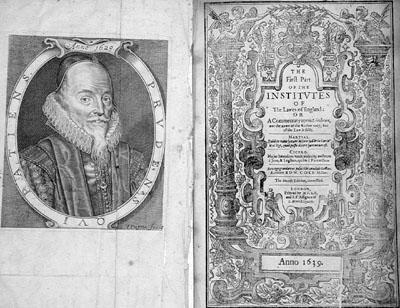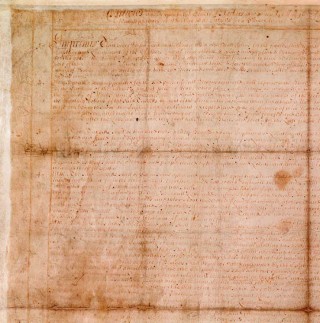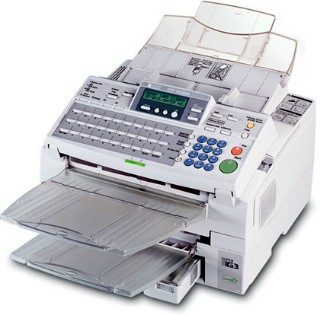|
Introduction
It
may seem strange to begin a discussion of 21st Century technologies,
and their use by the legal profession, almost 1500 years ago. But I begin this
story with Justinian’s Code, first
published in 533AD. The Code consisted, in essence, of three parts: the Institutes, a kind of basic text book of
fundamental legal principles; the Digest,
a collection of authoritative pronouncements on specific legal issues; and the Codex, a consolidation of legislative
provisions currently in force.
Why
do I begin this discussion with Justinian’s Code
? For the simple reason that, almost 1500 years later, the basic components of
legal research have not changed at all: to find an answer to a legal problem,
we still consult (though not necessarily in the same order) legal texts,
judicial authorities, and statutes.
|

Above: The Emperor Justinian,
483 – 565 AD
Right:
Justinian’s Code
(Codex Domini Justiniani), a fifteenth century edition
from the
Rare Book Room
of the
Boston College
Law Library
|

|
Let
us then turn the clock forward, through more than a millennium, to the man who,
almost single-handedly, transformed the English legal system into a modern,
systematic and rigorous discipline – Chief Justice Sir Edward Coke. Were this
the appropriate occasion, there are many things which I should like to say to
you about Coke, whom I regard as being incomparably the greatest figure in our
legal history. But for present purposes, it is only necessary to focus on one
of Coke’s many achievements.
The
latest technological advance in Coke’s England
was the printing press, invented by Johannes Gutenberg in the 15th
Century, and brought to England by William Caxton in the latter part of that Century. Of course, the growth of
technology was much slower in those times, and printing was still a relatively
modern science when Coke began publishing legal works in the late 1500s and
early 1600s.
Of
his fairly prodigious output of legal publications, perhaps the most
significant was The Reports – the
first English set of law reports, in the form that we have come to know them. So,
if you want to know who to blame for the small fortune which you pay each year
to Butterworths, the Law Book Company, and other publishing firms in order to
keep your professional libraries up-to-date, Sir Edward Coke is the main
culprit.
Apart
from The Reports, Coke also published
a multi-volume legal textbook, to which he gave the title (borrowed from
Justinian) of Institutes of the Laws of
England. Though there had been previous treatises published in respect of
specific branches of English law – the works of Bracton and Littleton are perhaps the best known – Coke
was the first to attempt an encyclopaedic text. His Institutes were the forerunner to publications such as Blackstone’s Commentaries and Halsbury’s Laws of England.
|

|

|
|
Lord Chief Justice Sir Edward Coke,
1552 - 1634
|
Sir Edward Coke’s
Institutes of the Laws of England
published between 1628 and 1641
|
But
that was not the limit of Coke’s innovation, or even the most significant
aspect of it. Coke may well have been the first writer in the English language,
and possibly the first writer in any language, to utilise footnotes. He did so
for one clear reason: for Coke, it was an article of faith that every legal pronouncement, contained in the Institutes, should be traced back to an
authoritative source – whether it was an Act of Parliament, a judicial
decision, or the opinion of an earlier text-writer. He thereby entrenched, and
perhaps invented, the approach to legal reasoning which all of us now regard as
second nature: that, in order to establish a proposition of law, it is
necessary to identify either a statutory provision or a judicial precedent
supporting the proposition or, failing either of those sources, the opinion of
a respected legal author. The three elements of legal research incorporated
into Justinian’s Code in 533AD were
repeated in Coke’s Institutes between
1628 and 1641, and have remained ever since the building-blocks of legal
reasoning, not only in England, but in every country to which the Common Law of
England has been transported.
In
Coke’s time, as I have said, printing was the very latest technology. Not only
did Coke found the system of jurisprudence which exists to this day; his
influence has been so great that, even today, many lawyers feel compelled to
use 16th Century technology when applying Coke’s system of
jurisprudence. Thus, if you walk into any solicitor’s office, any barrister’s
chambers, or indeed any Judge’s chambers, you will see the walls lined with a
lasting tribute to Sir Edward Coke, in the form of row upon row of legal books:
texts, reports and statutes. It is my proposition, simply put, that the time
has arrived to throw off the shackles of medićval technology, without
disturbing the fundamentals of legal learning and research which have
traditionally been presented to us in that antiquated technological format.
Lawyers
have not been slow to embrace technology in other areas of their practice, as I
might demonstrate by two anecdotes.
The
first concerns my own grandfather who, due to his Germanic background, was not
accepted for military service during the First World War. Instead, he gained
employment as a clerk in a solicitor’s office – the Brisbane firm of O’Shea & O’Shea, now
known as O’Shea, Corser & Wadley. His job, like Sir Joseph Porter in HMS Pinafore, was to “copy all the
letters in a big round hand”. Correspondence, advices, pleadings, affidavits –
indeed, all manner of legal documents – were produced by the partners in
long-hand, or dictated to my grandfather to be taken down in Pitman short-hand,
and then reproduced in copperplate script. In the absence of photocopiers, this
even included hand-written reproductions of evidentiary documents.
circa 1920:
hand-engrossed legal documents
replaced by the typewriter
I
doubt that anyone here laments the fact that this practice has given way to
typewriters, photocopiers and word processors, though in his recently published
monograph entitled Feez Ruthning &
Co. – The First Hundred Years, my father (Graeme Morris) makes the acerbic
observation that, when barristers started to employ typists, the length of
their opinions increased exponentially, without any noticeable change in the
quality of the advice provided.
The
other anecdote which I should like to share concerns the setting-up of my own
chambers, by Mr. G.E. Fitzgerald QC (as he then was), almost twenty years ago. When
my chambers were established, there was a serious debate as to whether we
should invest in a telex machine, or alternatively a facsimile machine. I doubt
that any member of the profession, aged under 40 – which is, these days, the
majority of the profession – has ever even seen a telex machine.
circa 1985:
the telex machine (teleprinter)
replaced by the fax machine
I
am not one of those who believes that the “paperless office”, any more than the
“paperless courtroom”, will become a practical reality in the foreseeable
future. I also must confess that I am something of a bibliophile, and that I
will always prefer to have books on my shelves, especially if they are
leather-bound, even though I recognise that they are increasingly valueless –
both in a monetary sense, and also in a utilitarian sense.
The
view which I do urge upon all of you, however, is this: within the service
industry that is the modern legal profession, it is incumbent on all of us to
shake off our troglodyte adherence to yesterday’s technologies, and examine the
ways that today’s technologies can help us to provide a better, more efficient,
and – most importantly of all – a less expensive service to our clients. On
this occasion, I should like to identify just a few basic ways in which we can
do this.
Legal Research
There
is now no excuse for any member of the legal profession not to utilise on-line
research facilities. Hard copies of law reports and statutes may still decorate
your reception area, but they are out of print before the ink is dry. There is
no reason why any lawyer should fail to refer to up-to-date statutory
provisions, or case-law, which is accessible from your own desktop – and often
at no cost.
It
is almost five years since I set up a website, called Lex Scripta and subtitled “Essential Web Links for Queensland
Lawyers”, in order to assist members of our profession to explore the research
options available on the Internet – not only to access statutes and caselaw,
but to access a huge range of other online facilities, from legal dictionaries,
to on-line translation services, to currency conversion facilities. Judging
from the number of “hits” which this site continues to receive, it is still
fulfilling a useful role in educating members of the legal profession as to the
availability of on-line research facilities.
Digital Dictation
We
all remember those old movies in which the business executive or professional
(invariably a man) “buzzes” a female stenographer, who walks into the man’s
office, sits down, takes out a pad and pencil, and proceeds to “take a letter”.
In the last 30 years or so, the use of analogue dictating machines – that is,
tape recorders – has become ubiquitous. Let me assure you that the time has now
arrived to throw out your tape recorder.
Digital
dictation is not only of higher quality, safer and more reliable than tape
recordings – you don’t have the problem of tapes which go missing or are
accidentally erased. It is also cheaper, because you don’t need tapes; and more
flexible, because digital files can be distributed and shared between staff in
a typing pool. It also offers a benefit which the old system simply cannot
match, because digital dictation files can be transmitted over the internet.
One
obvious application arises when you are working away from your office. You can
dictate a document, and then email it to your secretary, from the other side of
the city, the other side of the country, or the other side of the world.
Some
firms have now embraced this technology, to the extent that digital dictation
files are transmitted overnight to typing services in India or South-East Asia,
and then re-transmitted, in the form of completed documents, in the early hours
of the following morning. Whilst I am not personally convinced that this system
will ever compete with the competence and experience of an efficient legal
secretary, it may at least be an option in cases of urgency where a lengthy
document has to be typed overnight.
The
time may also come when voice recognition technology allows the lawyer merely
to speak into a microphone and have the spoken words automatically converted
into typescript. My own experience of such technologies is that they have not
yet reached an adequate level of reliability, so that the time spent in editing
a document produced by this technology makes it uneconomical. But, as with all
technologies, I expect that improvements will continue to occur exponentially.
Document Management
I
am reliably assured that, except perhaps in the very simplest cases, by far the
largest pre-trial cost in most civil litigation is incurred in respect of
discovery of documents, or “disclosure” as it is now called in some
jurisdictions. Technology can assist, not only to make the process more
efficient and less expensive, but also to make it more useful.
A
fairly minimilistic approach is to use a computerised document indexing system,
with individual documents bar-coded for efficient location and retrieval. But
that is just the beginning.
In
larger commercial cases, it is now becoming common to have all documents
scanned into a digital format, and then “burned” to a CD, or transferred to the
hard drive of a laptop computer, so that they can be accessed efficiently – in
the solicitor’s office, at the client’s office, in counsel’s chambers, or in
the courtroom – without having to photocopy and transport veritable
barrow-loads of paper.
The
fact that this saves a great deal of time and money – and, incidentally, a few
rainforests – should be enough, in itself, to encourage its adoption. But the
real benefit is the ability electronically to search documents in a digital
format. To take the very simplest example, just consider the advantages, when
cross-examining a witness, of being able to search for every mention of the
witness’s name in the discovered documents.
Co-operative Drafting
Commercial
lawyers are now well ahead of litigation lawyers in using Internet technology
to facilitate the drafting of detailed commercial agreements. But the same
technologies, which in all probability are currently being used by solicitors
in your firm’s commercial division, also offer significant advantages to
litigation lawyers.
Only
a few years ago, when lawyers representing opposing parties were collaborating
in the preparation of a lengthy commercial agreement, the process was a slow
and tedious one. A draft was prepared in solicitor A’s office, and was then sent
– by fax or “snail mail” – to solicitor B. In solicitor B’s office, it was
re-typed with solicitor B’s proposed emendations, and then returned to
solicitor A. And so the process continued, until both sides had a document
which was acceptable to them. Not only was the process slow and cumbersome; in
Benjamin Franklin’s words, there was “many a slip twixt cup and lip”. Lawyers
spent painstaking hours comparing each successive version of the draft, to
ensure that no disagreeable changes had been made, either accidentally or
deliberately.
Again,
exchanging drafts by email does not merely save time, money and paper – it also
reduces the risk of accidents, by allowing changes to be tracked
electronically.
In the Courtroom
In
light of the other presentations made this afternoon, I do not propose to dwell
over-long on the scope which exists to use the Internet and other digital
technologies in the courtroom. So I will just make three quick points.
First,
in complex cases, PowerPoint presentations and the like can be much more
effective in presenting opening and closing submissions and detailed evidence –
such as accounting evidence and other forms of expert testimony – to the
tribunal of fact, whether a Magistrate, a Judge or a Jury. Even being able to
project a piece of evidence on a screen in the courtroom makes it much easier
for everyone in the courtroom to follow a detailed analysis of the thing which
is being projected, whether it be an account, a plan, a diagram, or a
photograph.
Secondly,
as previously mentioned, a laptop computer with access to discovered documents
in a digital format is extremely efficient in assisting the search for relevant
entries, especially in a case where the documentary evidence is voluminous.
And
thirdly, most courts now offer the facility of providing transcripts in an
electronic format, which offers similar advantages – especially in a case
expected to run for more than a couple of days. In Queensland, there have been trials of “real
time” transcription services, which allow the parties’ legal representatives –
as well as the bench – not only to search the transcript as it is produced, but
also to highlight and annotate the transcript within seconds after the words
are spoken.
The Future
I
began this discussion with references to Justinian’s Code and Coke’s Institutes
to allay the concerns of the technophobes amongst us that computers, the
Internet, and other forms of digital technology are going to result in
fundamental changes to the law and the way that it is practised. That will not
happen.
The
essential work of a lawyer will never be replicated by a machine. We are not
like bank tellers, who can be replaced with ATMs. A computer will never be able
to take instructions from a client, or proof a witness, or draft an affidavit,
or settle a pleading, or present a case in court, or cross-examine a witness.
And no computer will ever sit in judgment.
These
technologies will not replace us or change what we do; they will only assist us
to do, more efficiently, the things which we already do. Nobody in the legal
profession need feel apprehensive that he or she will ever be displaced by even
the most sophisticated technology.
At
the same time, none of us can afford to bury our heads in the sand. As the
growth of technology increases, computer literacy will become an essential
qualification for legal professionals. We can, at the very least, look forward
to the existing technologies improving and becoming more widely used – for example,
real-time transcription services will become standard in the courtroom, rather
that a novel experiment; video links for directions hearings, and even the oral
testimony of witnesses, will become commonplace – not only to accommodate a
witness who is ill or in a remote location, but also (for example) to minimise
inconvenience to witnesses such as medical specialists.
I
wish that I could predict which new technologies will, even in 5 or 10 years’
time, be regarded as essential by all lawyers – if I knew that, I could make a
fortune on the stock-market by investing in the “dot com” shares. I don’t pretend
to know which specific technologies it will be, but I am absolutely certain
that there will be some.
The
bizarre thing with technology is that, when you don’t have it, you don’t know
how important it is; again, addressing my comments to the minority of us who
are under 40, let me remind you of a time – not so long ago – before mobile
phones became standard issue equipment even for articled clerks. In those days,
we thought nothing of going off to court with a pocket-full of 20 pieces, so
that we could use the pay-phones if necessary. If we had thought about it, we
might have guessed that mobile phones would be a useful innovation; but we
probably wouldn’t have anticipated that they would become indispensable.
In
the same way, the next technological innovation – whatever it may be – will one
day be regarded as vital. Those of you now aged in your twenties, when you are
in your forties, will be asked by fresh-faced juniors ... “How did you ever get
by without such-and-such ?”
As
I have said, I don’t pretend to know which specific technologies will, even in
5 or 10 years’ time, come to be regarded
by all lawyers as essential. Like you, I can only watch and wait – and keep an
open mind.
Conclusions
In
all walks of life, adaptation to the use of computers and digital technology
has met with some resistance. Extraordinarily, even in the computer industry
itself, such resistance has been more common that you might expect.
- In
1943, the founder and chairman of IBM, Thomas Watson, expressed the view that
“there is a world market for maybe five computers”.
- In
1949, Popular Mechanics magazine
predicted that “Computers in future may weigh no more than 1.5 tons”.
- More recently, in 1977, the founder and chairman of Digital Electronics Corporation,
Ken Olsen, could not understand why “anyone would want a computer in their
home”.
- And
even Bill Gates, of MicroSoft fame, is on record as saying that he could not
see why anyone “would ever need more than 640 kilobytes of RAM” (Gates, of
course, provided the answer to his own rhetorical question, by producing
software so bloated that it cannot function except on the most high-powered
computers).
These
various predictions are on a par with the pronouncement of the British
Astronomer Royal, Richard Woolley, in 1956, that “Space travel is utter bilge”
– less than twelve months later, Sputnik went into orbit.
In
a similar vein, let me conclude by quoting from a 1962 article by Frederick B.
Wiener in the American Bar Association
Journal:
“In short, members of the Bar will be well advised to
stay very far away from computers if they want to remain – or become – lawyers
rather than simply attorneys at law. Computers are fine for inertial guidance
problems – but the law is neither a missile nor an atomic submarine.”
I
beg to differ. A soldier going into battle, armed only with a flintlock musket,
will be no match for one armed with the latest weaponry produced by 21st
Century technology. In equal proportion, a lawyer who insists on using only
medićval technologies, in conducting a courtroom battle on a client’s behalf,
is no match for the lawyer who embraces everything which is offered by computers,
the Internet, and other forms of digital technology.
|










